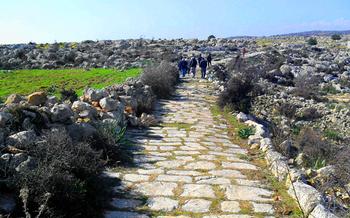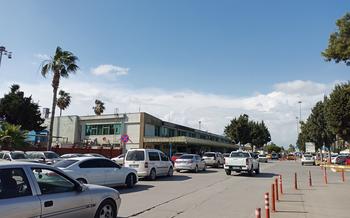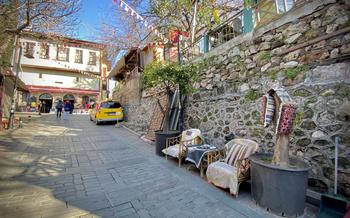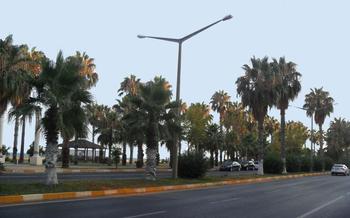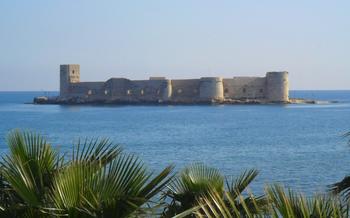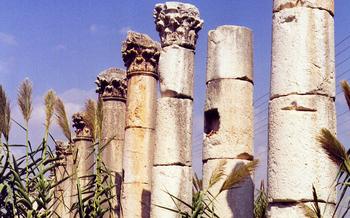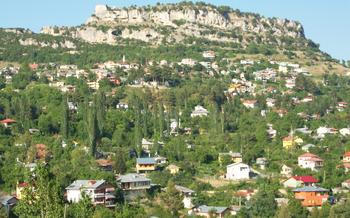
Ancient City of Corycus
- Corycus: Antiquity and Intrigue
- Reaching the Ancient City of Corycus
- Exploring the Ruins of Corycus
- Layout and Structure of the Ancient City
- Key Landmarks and Architectural Highlights
- Preserved Mosaics, Inscriptions, and Artifacts
- The Theater of Corycus: A Majestic Spectacle
- The Necropolis of Corycus: Silent Sentinels
- The Church of Corycus: A Byzantine Legacy
- The Aqueduct of Corycus: An Engineering Masterpiece
- The Agora of Corycus: Bustling Marketplace
- The Walls of Corycus: Fortified Protection
- The Olive Groves of Corycus: A Culinary Delight
- The Beaches of Corycus: Serenity by the Sea
- Local Cuisine: A Culinary Journey
- Accommodations in Mersin: A Range of Options
- Festivals and Events in Mersin: Celebrating Culture
- Insider Tip: Unveiling Hidden Gems
Corycus: Antiquity and Intrigue
In the heart of Mersin, Turkey, lies the ancient city of Corycus, a place steeped in historical significance and shrouded in captivating myths and legends. Once a thriving port city and a strategic crossroads of ancient civilizations, Corycus has left behind a legacy that continues to intrigue and inspire.
Archaeological excavations have unearthed remarkable treasures that shed light on the city's rich past. From well-preserved mosaics and inscriptions to artifacts of everyday life, these discoveries provide a glimpse into the vibrant culture and daily life of Corycus's inhabitants. Ongoing excavations continue to reveal new secrets, adding to the allure of this enigmatic city.
Reaching the Ancient City of Corycus
The ancient city of Corycus is situated approximately 25 kilometers west of Mersin, making it an accessible day trip from the city. To reach Corycus, you can opt for various transportation options depending on your preferences and budget.
By Public Transportation:
From Mersin, you can take a local bus or minibus heading to Silifke. These buses depart regularly from the main bus terminal and take about an hour to reach Silifke. Once in Silifke, you can transfer to another bus or minibus going to the village of Kızkalesi. From Kızkalesi, you can either walk or take a short taxi ride to the ancient city.
By Rental Car:
Renting a car offers greater flexibility and allows you to explore the region at your own pace. From Mersin, take the D400 highway west towards Silifke. After about 25 kilometers, you will see signs for Corycus on the left side of the road. Follow these signs to reach the ancient city.
Guided Tours:
Several tour operators in Mersin offer guided tours to Corycus. These tours typically include transportation, a knowledgeable guide, and entrance fees. Guided tours are a great option for those who want to learn more about the history and significance of Corycus while exploring the site.
Independent Exploration:
For those who prefer a more independent experience, exploring Corycus on your own is also possible. The site is well-marked, and there are information boards in both Turkish and English providing historical context. However, it's worth noting that guided tours offer a deeper understanding of the site and its significance.
Exploring the Ruins of Corycus
The ancient city of Corycus reveals its captivating story through the ruins that stand as silent witnesses to its glorious past. As you wander through the archaeological site, you'll encounter various structures, each offering a glimpse into the lives of the people who once called this place home.
Layout and Structure of the Ancient City
The city's layout follows a grid plan, with streets intersecting at right angles. Public buildings, temples, and marketplaces were strategically positioned along these streets, creating a sense of order and organization. Residential areas, with their smaller houses and courtyards, were tucked away in quieter corners.
Key Landmarks and Architectural Highlights
Among the most impressive landmarks is the theater, a magnificent structure that could accommodate thousands of spectators. Its well-preserved stage and seating areas hint at the lively theatrical performances that once took place here. Other notable buildings include temples dedicated to various deities, administrative buildings, and public baths, each showcasing intricate architectural details and craftsmanship.
Preserved Mosaics, Inscriptions, and Artifacts
Throughout the site, you'll discover stunning mosaics that adorn the floors of public buildings and private homes. These intricate artworks depict mythological scenes, geometric patterns, and everyday life, offering valuable insights into the artistic traditions of Corycus. Additionally, inscriptions and artifacts unearthed during excavations provide further clues about the city's history, economy, and social structure.
The Theater of Corycus: A Majestic Spectacle
The ancient theater of Corycus stands as a testament to the city's cultural and artistic heritage. Carved into the natural slope of a hill, the theater offered breathtaking views of the Mediterranean Sea, enhancing the theatrical experience. With a seating capacity estimated to accommodate over 5,000 spectators, the theater's impressive scale speaks to the significance of entertainment in ancient Corycus.
The theater's construction showcased remarkable architectural prowess. Its tiers of seating were supported by intricate vaulted structures, ensuring stability and providing excellent sightlines for the audience. The stage area, adorned with elaborate columns and niches, exuded grandeur and provided a fitting backdrop for theatrical performances.
Acoustical marvels were integral to the theater's design. The carefully calculated angles of the seating and stage ensured optimal sound projection, allowing the actors' voices to carry throughout the auditorium without the need for amplification. This acoustic engineering feat contributed to the immersive and engaging atmosphere of theatrical productions.
Today, the theater of Corycus undergoes extensive restoration efforts aimed at preserving its grandeur for future generations. The restoration project focuses on stabilizing the structure, conserving the intricate carvings and decorative elements, and improving accessibility for visitors. Plans are underway to host theatrical performances and cultural events within the restored theater, bringing it back to life as a vibrant hub for the performing arts.
The Necropolis of Corycus: Silent Sentinels
Lying just outside the ancient city walls, the necropolis of Corycus serves as a poignant reminder of the city's rich past and the lives of its inhabitants. This vast cemetery, with its rows of tombs and mausoleums, offers a glimpse into the burial practices and beliefs of the ancient Corycians.
The tombs vary in size and design, reflecting the social status and wealth of the deceased. Some are simple, single-chambered structures, while others are elaborate, multi-room complexes with intricate facades and sculpted decorations. Many of the tombs feature inscriptions and epitaphs, providing valuable insights into the lives and families of the buried.
The necropolis also contains several larger mausoleums, which were likely reserved for the city's most prominent citizens. These structures are often adorned with elaborate carvings and reliefs, depicting scenes from mythology, daily life, and religious rituals. Some of the mausoleums even feature small altars or shrines, suggesting that they were used for family worship or commemorative ceremonies.
Exploring the necropolis of Corycus is a moving and thought-provoking experience, offering a glimpse into the lives and deaths of the ancient Corycians. It is a place to reflect on the passage of time, the enduring nature of human memory, and the rich cultural heritage that this ancient city has to offer.
The Church of Corycus: A Byzantine Legacy
The Church of Corycus stands as a testament to the city's rich Byzantine heritage. Built during the 5th or 6th century AD, this architectural masterpiece showcases the grandeur and artistry of the Byzantine era. Its impressive size and intricate design suggest that it was once a prominent religious center in the region.
The church features a traditional basilica plan, with a central nave flanked by two side aisles. Its interior is adorned with well-preserved frescoes and iconography, depicting scenes from the Bible and the lives of saints. These colorful murals offer a glimpse into the religious beliefs and practices of the Byzantine people.
While the exact purpose of the church remains uncertain, it is believed to have served as a place of worship, community gatherings, and religious instruction. Its strategic location within the city walls suggests that it played a significant role in the spiritual and social life of Corycus.
Today, the Church of Corycus stands as a reminder of the city's Byzantine past. Despite the passage of time and the ravages of history, it continues to exude an aura of sanctity and reverence. Visitors can explore its ruins, marvel at its preserved artwork, and contemplate the rich history that unfolds within its walls.
The Aqueduct of Corycus: An Engineering Masterpiece
The aqueduct of Corycus stands as a testament to the ingenuity and engineering prowess of the ancient city's inhabitants. This remarkable structure, designed to provide a reliable water supply to the city, showcases the advanced hydraulic knowledge of the past.
Built during the Roman period, the aqueduct stretched for several kilometers, bringing water from distant sources to the heart of Corycus. Its intricate system of channels, pipes, and tunnels ensured a continuous flow of fresh water, essential for the city's daily life, sanitation, and agricultural needs.
The aqueduct's source was a natural spring or reservoir located in the surrounding hills. From there, water was carefully channeled through a network of underground pipes, skillfully constructed to maintain a gentle gradient and prevent blockages. The pipes were made of clay or stone, fitted together with precision to withstand the pressure and ensure a steady flow.
At strategic intervals, the aqueduct featured inspection chambers, allowing for maintenance and repairs. These chambers also served as ventilation points, preventing the buildup of harmful gases within the system.
As the water approached the city, it was distributed through a series of distribution tanks and smaller pipes, ensuring that every household and public fountain had access to clean and reliable water. The aqueduct's design also incorporated overflow channels to prevent flooding and damage during heavy rains.
The aqueduct of Corycus not only provided a vital resource for the city's inhabitants but also showcased their commitment to urban planning and infrastructure development. Its enduring legacy serves as a reminder of the ingenuity and engineering skills that shaped ancient civilizations.
The Agora of Corycus: Bustling Marketplace
The agora, or marketplace, was the vibrant heart of ancient Corycus, a place where commerce thrived and social interactions flourished. Located in the center of the city, the agora was a spacious area surrounded by colonnades and shops. Here, merchants from near and far gathered to trade their wares, from exotic spices and fine textiles to locally produced pottery and agricultural goods.
The agora was not merely a place of economic exchange but also a social and cultural hub. It was a place where people from all walks of life came together to socialize, exchange news, and participate in political and religious gatherings. The agora was often the site of festivals, celebrations, and public announcements.
The layout of the agora was carefully planned to facilitate trade and movement. The colonnades provided shade and shelter from the sun and rain, while the open spaces in between allowed for easy access to the shops. The shops themselves were typically small, with a narrow frontage and a deep interior, providing ample space for storage and display of goods.
Archaeological excavations have revealed the remains of several shops in the agora, each with its unique features and artifacts. Some shops were equipped with counters, shelves, and storage jars, while others had kilns or furnaces for pottery or metalworking. Inscriptions found on the walls of the shops provide insights into the types of goods that were traded, such as wine, oil, grain, and textiles.
The agora of Corycus was a bustling center of activity, a place where the city's economy and culture converged. It was a place where people from different backgrounds came together to exchange goods, ideas, and experiences, contributing to the vibrant tapestry of life in ancient Corycus.
The Walls of Corycus: Fortified Protection
The ancient city of Corycus was once a well-defended settlement, protected by a formidable system of walls. These walls, constructed with thick stone blocks, encircled the city, forming a sturdy barrier against potential invaders.
The walls featured several gates, each heavily fortified with towers and other defensive structures. These gates served as controlled access points to the city, allowing for the regulation of movement and trade.
Corycus's walls withstood numerous sieges and battles throughout history, testament to their strength and strategic importance. The city's resilience in the face of adversity is a testament to the engineering prowess of its ancient builders.
Today, visitors can still admire the remnants of these impressive fortifications, which offer a glimpse into the city's rich military history. The walls of Corycus stand as silent witnesses to the tumultuous events that shaped the city's destiny.
The Olive Groves of Corycus: A Culinary Delight
Olive cultivation has deep roots in the region surrounding Corycus. The fertile soil and favorable climate provide an ideal environment for these ancient trees to flourish. Local farmers have cultivated olive groves for generations, passing down traditions and techniques that have remained largely unchanged over time.
The olive varieties grown in Corycus are unique to the region, producing olives that are larger and more flavorful than those found elsewhere. The local climate contributes to the distinct taste and aroma of the olives, which are known for their rich, fruity flavor and a hint of bitterness.
Olive oil production in Corycus is a traditional and integral part of the local economy. Farmers harvest the olives by hand, carefully selecting the ripest and healthiest fruits. The olives are then pressed using traditional methods to extract the precious oil. The resulting olive oil is of exceptional quality, with a golden-green color, a smooth texture, and a well-balanced flavor.
Culinary traditions in Corycus revolve around the use of fresh, locally-sourced ingredients, including olive oil, seafood, and vegetables. Olive oil is used in abundance in cooking, adding a rich flavor to dishes such as stews, salads, and grilled meats. The local cuisine is simple yet delicious, reflecting the region's deep connection to the land and its produce.
The Beaches of Corycus: Serenity by the Sea
The ancient city of Corycus not only boasts historical wonders but also offers a serene escape along its picturesque coastline. Just a short distance from the ruins, visitors can find a string of beautiful beaches, inviting them to indulge in sun-soaked relaxation or partake in exhilarating water activities.
Azure Waters and Sandy Shores: The beaches of Corycus are renowned for their crystal-clear waters, where shades of turquoise and sapphire dance in the sunlight. The sandy shores, soft and golden underfoot, provide the perfect spot to unwind and soak up the Mediterranean sun. Whether you prefer to bask in the warmth or build sandcastles with the kids, these beaches offer an idyllic setting for a carefree day by the sea.
Swimming, Sunbathing, and Water Sports: The calm waters of Corycus's beaches make them ideal for swimming, allowing visitors to float effortlessly and explore the underwater world teeming with marine life. Sunbathing enthusiasts can find secluded coves and sheltered spots to relax and work on their tan while enjoying the gentle sea breeze. For those seeking adventure, water sports such as snorkeling, diving, and paddleboarding are available, offering a chance to explore the crystal-clear depths and encounter the vibrant marine ecosystem.
Scenic Views and Coastal Vistas: The beaches of Corycus offer breathtaking views of the Mediterranean Sea, where the horizon stretches endlessly and the sky blends seamlessly with the water. Rocky outcrops and verdant hills frame the coastline, creating a picturesque backdrop for long walks along the shore. As the sun dips below the horizon, the sky transforms into a canvas of vibrant colors, painting a magical scene that will leave you spellbound.
Local Cuisine: A Culinary Journey
Mersin, with its rich history and diverse cultural influences, offers a tantalizing culinary experience for food enthusiasts. The city's cuisine is a harmonious blend of Turkish, Mediterranean, and Middle Eastern flavors, showcasing the region's fresh produce, aromatic spices, and culinary traditions.
Fresh seafood, a cornerstone of Mersin's cuisine, is a must-try. The city's proximity to the Mediterranean Sea ensures a steady supply of freshly caught fish and shellfish, which are often grilled, fried, or stewed to perfection. Indulge in the succulent flavors of sea bass, sea bream, or red mullet, accompanied by tangy sauces and vibrant salads.
Local produce plays a starring role in Mersin's cuisine, with an abundance of fruits and vegetables grown in the fertile soils of the region. Eggplants, tomatoes, peppers, and okra are transformed into delicious stews, salads, and mezzes. Savor the sweetness of locally grown citrus fruits, such as oranges, mandarins, and lemons, which are often used in desserts, beverages, and marinades.
Olive oil, a staple ingredient in Mediterranean cuisine, holds a special place in Mersin's culinary heritage. The region's olive groves produce a rich, flavorful olive oil that is used generously in cooking and drizzled over dishes to enhance their taste. Experience the distinct flavors of local olive oil in salads, dips, and traditional Turkish dishes like "zeytinyağlı dishes," where vegetables are slowly cooked in olive oil with herbs and spices.
Mersin's restaurants and cafes offer a range of dining experiences, catering to diverse tastes and budgets. From traditional Turkish eateries serving home-style dishes to upscale restaurants offering innovative interpretations of local cuisine, there's something for every palate. Don't miss the opportunity to savor the culinary delights of Mersin, where every meal is a journey into the region's rich flavors and traditions.
Accommodations in Mersin: A Range of Options
When planning your trip to Mersin, you'll find a diverse range of accommodation options to suit every budget and preference. From luxurious hotels to cozy guesthouses and budget-friendly hostels, there's something for every traveler.
Hotels: For a comfortable and convenient stay, consider booking a room at one of Mersin's many hotels. These establishments offer a range of amenities, including comfortable rooms, private bathrooms, air conditioning, and often additional facilities like swimming pools, fitness centers, and restaurants.
Guesthouses: For a more intimate and local experience, opt for a guesthouse. These small, family-run establishments provide a warm and welcoming atmosphere, along with comfortable rooms and often delicious home-cooked meals. Guesthouses are a great way to connect with locals and gain insights into Turkish culture.
Vacation Rentals: For a more independent and flexible stay, consider renting an apartment or villa. This option is ideal for families or groups traveling together, as it offers more space and privacy. Vacation rentals can be found in various locations throughout Mersin, allowing you to choose a place that suits your needs and budget.
Tips for Finding Affordable and Comfortable Lodging:
- Book in advance, especially during peak season, to secure the best rates and availability.
- Consider staying in a guesthouse or vacation rental for a more affordable and local experience.
- Look for hotels or guesthouses that offer discounts or special packages.
- Don't be afraid to negotiate prices, especially if you're staying for multiple nights.
- Check online reviews and ratings to get a sense of the quality and service of different accommodations.
Festivals and Events in Mersin: Celebrating Culture
Mersin, a vibrant city in southern Turkey, hosts a diverse array of festivals and events throughout the year, showcasing its rich cultural heritage and providing visitors with unique opportunities to immerse themselves in local traditions. These events offer a kaleidoscope of colors, sounds, and flavors, allowing visitors to experience the true essence of Mersin.
One of the most popular events is the Mersin International Music Festival, held annually in July. This prestigious festival brings together renowned musicians from Turkey and around the world, filling the city with melodious tunes and enchanting performances. The festival features a variety of genres, from classical to jazz, rock, and traditional Turkish music, ensuring that there is something for every taste.
Another highlight is the Mersin Dance Festival, held in August. This colorful event showcases the diverse dance traditions of Turkey and the Mediterranean region. From traditional folk dances to contemporary ballet and modern dance, the festival offers a feast for the eyes and an opportunity to witness the incredible talent and artistry of local and international dancers.
For those interested in history and culture, the Mersin Culture and Arts Festival, held in September, is a must-attend event. This festival celebrates the rich cultural heritage of Mersin and the surrounding region, featuring exhibitions, workshops, and performances that delve into the city's past and present. Visitors can explore ancient artifacts, learn about traditional crafts, and experience the vibrant local culture firsthand.
These festivals and events offer visitors a chance to connect with the local community, learn about Turkish customs and traditions, and create lasting memories. Whether you are a music enthusiast, a dance aficionado, or simply someone who loves to experience new cultures, Mersin's festivals and events promise an unforgettable and enriching journey.
Insider Tip: Unveiling Hidden Gems
Beyond the main attractions of Corycus, there are hidden gems waiting to be discovered. Venture off the beaten path and explore the lesser-known corners of this ancient city to uncover its true essence. Seek out the secluded coves and pristine beaches that dot the coastline, where you can bask in tranquility and soak up the Mediterranean sun. Discover the hidden courtyards and narrow alleys that wind through the old town, where you can stumble upon charming cafes, artisan shops, and traditional restaurants that offer a taste of local life. Engage with the locals, who will gladly share their stories and insights, providing you with a deeper understanding of the city's culture and heritage. Uncover the hidden treasures of Corycus, and create memories that will last a lifetime.
